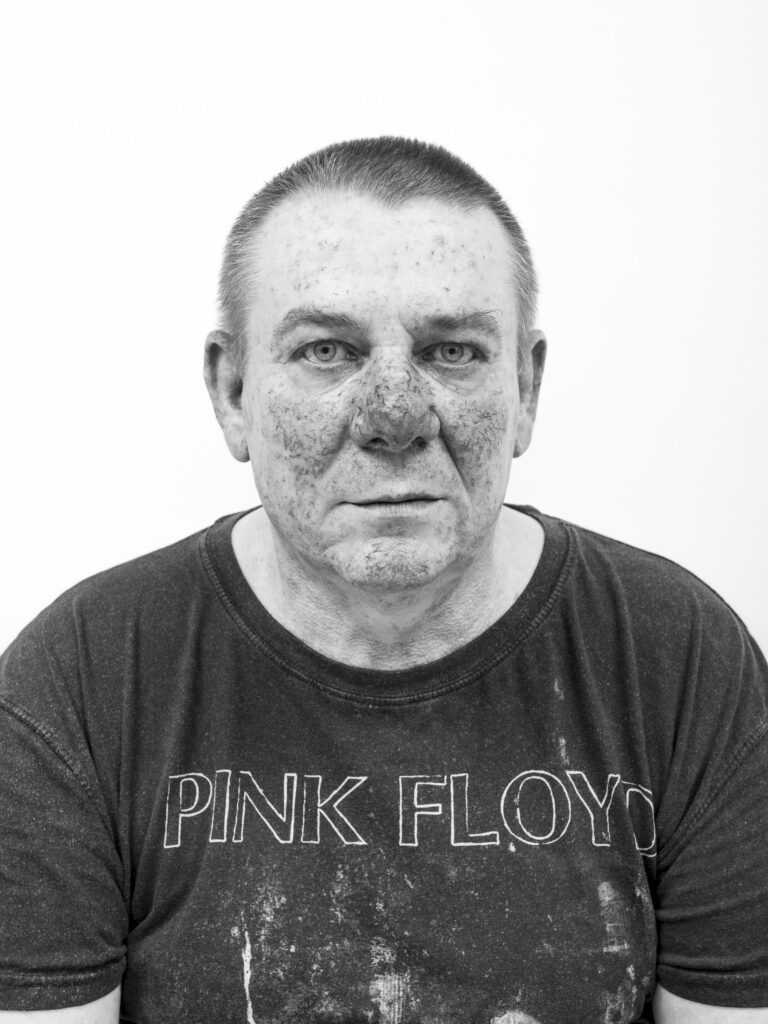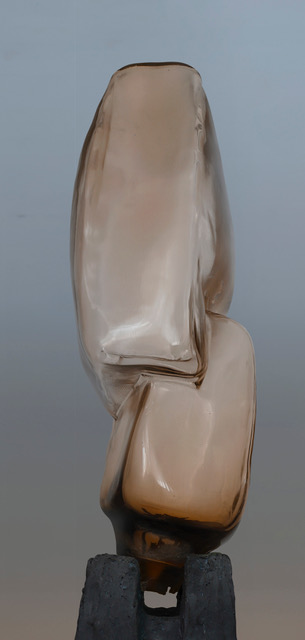Published 1 SEP 2024
Eric Meier
Vaterland
Opening – 5 SEP, 5-9 pm
5 SEP until 26 OCT 2024
EIGEN + ART Lab

Eric Meier
TL_DARKSIDE_OF_THE_MOON_I, 2024
Archival Pigment Print
145 x 107 cm
Courtesy the artist and EIGEN + ART Lab
„What makes loneliness so unbearable is the loss of one’s own self which can be realized in solitude, but confirmed in its identity only by the trusting and trustworthy company of my equals. In this situation, man loses trust in himself as the partner of his thoughts and that elementary confidence in the world which is necessary to make experiences at all. Self and world, capacity for thought and experience are lost at the same time.“
– Hannah Arendt: The Origins of Totalitarianism, The World Publishing Company, Ohio 1958, p. 477)
Eyes, it is said, are the window to the soul. They have the ability to reflect lies, humour, pain and joy. If you look into the eyes of the people portrayed by Eric Meier, pale faces return your gaze, tired and empty. They bear witness to a long-overlooked fate in the history of East German transformation after reunification. With his „Vaterland“ (Fatherland) series of works, which shows men from a residential centre for alcoholics in Eisenhüttenstadt, the artist, who was born in East Berlin and grew up in Frankfurt an der Oder, undertakes a memorable and touching contemplation of this history, giving new visibility to people forgotten by society.
In doing so, he focuses his gaze on what many might turn away from. Like an archaeologist, he uncovers the traces that the fall of the Wall and the accompanying changes left on people and cities in all their ambivalence. The resulting images of the alcoholic men are distinctly unembellished and honest. Every part of their bodies is ruthlessly scrutinised, the gaze directed at legs marked by scars, necks stained by sweat and hands shaped by work. With their backs bent by the weight of the past, the subjects hang limply in their chairs, their posture appearing as a grotesque quotation of a long-lost pose of masculinity. What once stood for strength and self-confidence now reveals an irrepressible vulnerability in its brokenness.
[…]
The past and present of the East is carved in stone. As sociologist Steffen Mau shows, it has never disappeared and continues to determine the reality of life for the people living there. Society must not ignore the associated life stories, but rather take a closer look and bring them to the centre of our social reflection, especially in view of the political situation in the new federal states. Eric Meier’s exhibition sets a good example in an expressive and at the same time very sensitive way by dealing with the past in its sometimes confusing ambivalence and complexity and thus critically commenting on the present and the future.
Extract from press release by Friedrich Weißbach
Kai Schiemenz
PRIEL
Opening – 12 SEP 2024, 5-8 pm
12 SEP until 9 NOV 2024
Galerie EIGEN + ART Berlin

EIGEN + ART: Last year, you published a catalog titled “Priel”. To what degree is this exhibition based on the concepts described in this catalog, and how have you further developed them substantively?
Kai Schiemenz: The word “Priel” is used in German to describe a narrow channel in a mudflat created by the tides. It is sometimes visible at low tide, but then at high tide perceptible only as a current under the surface of the sea. Such tideways are out-flushings from continuously branching, meandering river courses. In the first place, this is an image I like: a river that flows into the sea and takes on a new character because of the moon and its gravity. My work with glass is similar. Here I altered my work method, and with it the parameters and the emerging artwork. In this sense, the title of the exhibition is programmatic and a continuation of what is inherent in the catalog “Priel”.
E+A: You mention the material, glass, with which you have long worked and that is very present here, as well. This time, you have brought it into novel forms placed on pedestals that are themselves powerfully expressive. What led to this change in your works, and what does that mean to you?
Kai Schiemenz: The new sculptures are blown from glass, unlike my earlier works, which were usually cast in glass. Although they are made of the same material, they look entirely new. Maybe the change in my method can be compared to a cross-country skier who decides to shift to the downhill discipline, maybe because he is bored, maybe because he wants to try out something new and expand his experience. Downhill skiing is thereby much faster, and the time before he arrives at the bottom is quite short. It’s similar with glass-blowing: the speed of implementation is quite different from when you cast glass, which often takes months. In addition, I have little experience with this new work method, which entails certain freedoms. I did things that are normally avoided. I did that out of ignorance and to avoid the logic of production. Maybe that’s not rational. But rationality isn’t everything, after all.
E+A: The sculptures that result seem to be greatly influenced by chance. And viewers can hardly judge their weight, for example. How would you describe the result for yourself?
Kai Schiemenz:: Unpredictable! When casting glass, the model is essential and a fundamental part of the work. When blowing glass, the occasion is what’s important. The essence of the sculpture is now the process, which emerges through the rapid sequence of decisions. If “Priel” is a flushing out, then I would supplement this comparison with the motion on the water in a delta. If I sail on a ship toward the sea, I have to make a new decision at every branching of the river delta. I can take the right or the left branch on my way to the sea. It’s similar when producing a sculpture: whether I take the right-hand or the left-hand branch, ultimately I reach the sea, unless I get stuck in a swamp. The timbre and tonality changes at every branching. First it grumbles, then it crackles and acts mean, later, in turn, it turns shy and reserved
E+A: You describe how the glass artworks begin to speak in this new context. What kind of communication do you engage in with the materials of the other sculptures? In what relation do they stand to each other?
Kai Schiemenz:: The beginning for this exhibition were the sculpture of blown glass. In their production, models in Styrofoam, negative forms in sheet steel, and various derivatives were left over. Fragments that became sculptures in their turn and that stand in relation to the rest. Pieces of Styrofoam with holes, cylinders lying on unsuccessful casting attempts. For me, this is a landscape consisting of experiments – a very romantic idea.
